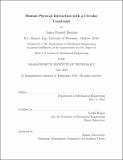| dc.contributor.advisor | Neville Hogan. | en_US |
| dc.contributor.author | Hermus, James Russell | en_US |
| dc.contributor.other | Massachusetts Institute of Technology. Department of Mechanical Engineering. | en_US |
| dc.date.accessioned | 2018-10-22T18:27:37Z | |
| dc.date.available | 2018-10-22T18:27:37Z | |
| dc.date.copyright | 2018 | en_US |
| dc.date.issued | 2018 | en_US |
| dc.identifier.uri | http://hdl.handle.net/1721.1/118670 | |
| dc.description | Thesis: S.M., Massachusetts Institute of Technology, Department of Mechanical Engineering, 2018. | en_US |
| dc.description | This electronic version was submitted by the student author. The certified thesis is available in the Institute Archives and Special Collections. | en_US |
| dc.description | Cataloged from student-submitted PDF version of thesis. | en_US |
| dc.description | Includes bibliographical references (pages 113-119). | en_US |
| dc.description.abstract | Despite large feedback delays, and many degrees of freedom, humans are incredibly dexterous and excel at physical interaction with complex objects. In this work we developed an upper limb crank turning experiment to study the human controller used to manage physical interaction. Subjects turned a crank with and without visual feedback, in two directions (clockwise and counterclockwise), and in three speed conditions (slow (0.075 rev/s), medium (0.5 rev/s), and fast (2 rev/s)). We made several predictions about the dependent measures including: mean speed, standard deviation of speed, coefficient of variation of speed, mean normal force, and standard deviation of normal force. We hypothesized that subjects should perform the best at slow speeds where the effect of feedback delays, inertial dynamics, and muscle noise decrease. Notably, subjects became more variable at slow speeds, and exerted significant nonzero normal force in the slow condition. At slow speeds, increased speed variability and compressive normal forces cannot be explained by biomechanics - suggesting they result from neural control. Next, the zero-force trajectory was computed. The zero-force trajectory allows for the peripheral biomechanics to be 'subtracted' to 'reveal' the underlying neural commands, expressed in terms of motion. We detected a coincidence of curvature and velocity extrema in the zero-force trajectory. Furthermore, this observation was robust to changes in impedance parameters. This finding is exciting. Even though the hand was confined to a circular path, when the peripheral biomechanics were subtracted, the same velocity curvature relationship seen in unconstrained movements was revealed. Lastly, the increased variability at slow speeds was present in the zero force trajectory. This indicates that the increased variability at slow speeds is a result of neural control, not biomechanics; this finding is consistent with previous research in unconstrained motion. | en_US |
| dc.description.sponsorship | National Science Foundation National Robotics Initiative Grant No. 1637824 | en_US |
| dc.description.statementofresponsibility | by James Russell Hermus. | en_US |
| dc.format.extent | 119 pages | en_US |
| dc.language.iso | eng | en_US |
| dc.publisher | Massachusetts Institute of Technology | en_US |
| dc.rights | MIT theses are protected by copyright. They may be viewed, downloaded, or printed from this source but further reproduction or distribution in any format is prohibited without written permission. | en_US |
| dc.rights.uri | http://dspace.mit.edu/handle/1721.1/7582 | en_US |
| dc.subject | Mechanical Engineering. | en_US |
| dc.title | Human physical interaction with a circular constraint | en_US |
| dc.type | Thesis | en_US |
| dc.description.degree | S.M. | en_US |
| dc.contributor.department | Massachusetts Institute of Technology. Department of Mechanical Engineering | |
| dc.identifier.oclc | 1057343221 | en_US |
